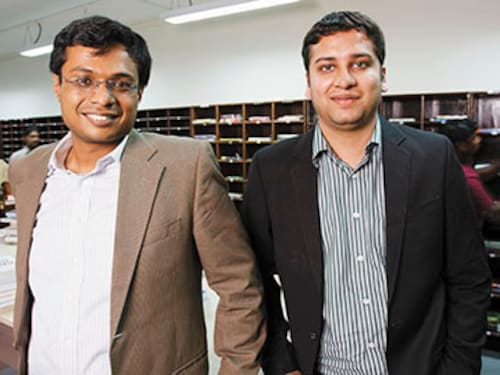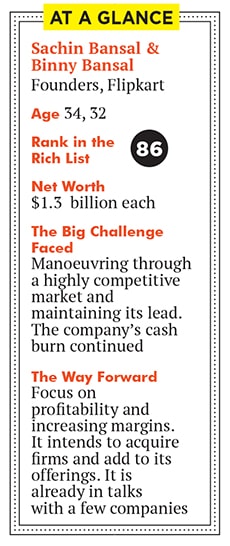Bansals epitomise the rise of India's e-billionaires
With their entry into the 2015 Forbes India Rich List, Sachin and Binny Bansal, founders of Flipkart, have reaffirmed their position as the country's leading consumer internet entrepreneurs


They may have started the company from their two-bedroom apartment but will soon be operating out of an over 2 million sq ft space in the swanky Embassy Office Parks in Bengaluru’s Outer Ring Road.
In May this year, Sachin Bansal and Binny Bansal, founders of Flipkart, India’s ecommerce poster boy, signed one of India’s largest office space deals in recent times. For the premises, Flipkart will fork out nearly Rs 17 crore in office rent per month.Keeping them company at their new office will be several IT giants like Accenture, Alcatel-Lucent, Honeywell and IBM, who have all homed in on this much sought-after commercial area of the Indian Silicon Valley.
The space and the rent, and even the company, certainly befit the Bansals, the two newest entrants to the 2015 Forbes India Rich List, in which they debut at 86, with a net worth of $1.3 billion each this year. Incidentally, at 32, Binny Bansal is the youngest on the list.
The two men, who started the business merely eight years ago by pooling in Rs 2 lakh each along with two computers, have been at the vanguard of the new economy boom in India. It is only appropriate that they are the first e-entrepreneurs to make this list.
The Bansals (who are not related) started their ecommerce venture after quitting their jobs at Amazon Web Services, the cloud computing services platform of Amazon, in Bengaluru. Sachin, the older at 34, and Binny were both software engineers there, having graduated from IIT-Delhi.
By all measures, it is a fair distance to travel in a journey that started only in 2007, and that too with an idea that they knew wasn’t novel. Instead, their company would ‘differentiate’ by giving customers such good service that they would keep coming back for more.
The Customer Hook
“If it wasn’t for these two, many companies would have replicated what Flipkart is doing,” says Sanjay Anandaram, a renowned entrepreneur-turned-investor, who also mentors startups. “They have a grand vision they are not in the business to get rich quickly and want to create something of a legacy… all this needs is time, effort, money and people, and they have turned it all in.”
They launched Flipkart with books, a category which doesn’t need the ‘touch and feel’ experience and could generate repeat customers. There were a handful of orders in the beginning and most customers would get a personalised email from Binny upon the completion of their purchase. But books were just the start. In 2010, the company got into music, movies and mobiles and started the ‘cash-on-delivery’ mode of payment, one of the biggest innovations in the Indian ecommerce industry. Credit card penetration is low in the country and a large percentage of Indian customers were hesitant to use their debit cards online, fearing fraud. A year later, Flipkart even started the card-on-delivery facility. To allay the fears of customers about whether they would get what they saw on the site, it started offering a 30-day replacement policy too.
In the meantime, it added other categories like electronics and apparel. In 2014, it acquired Myntra for an undisclosed amount after realising that unlike books and electronics (which are a volume play), apparel and fashion need category specialisation, a deep understanding of style, designing and aesthetics. The deal not only strengthened Flipkart’s position in the fast-growing online retail space, it also gave it enough ammunition to take on the deep-pocketed and fast emerging global ecommerce giant Amazon, which had started its India portal in 2013.
Flipkart is a pioneer in more ways than one, says Harminder Sahni, founder and managing director, Wazir Advisors, a retail consulting firm. According to him, Flipkart understands pain points better as it has access to the largest amount of data available on customers due to its reach. “And given the size of its business and the funding backup, it [Flipkart] was able to react to customer pain points faster,” says Sahni. “Others couldn’t implement this faster because it required the kind of management bandwidth and capital which Flipkart had.”
Building Value
Its understanding of customers worked well for Flipkart. Today, it is the country’s largest ecommerce site worth $15.2 billion, a valuation not many traditional business houses can boast of and very few in the startup category space can. (In comparison, Snapdeal, the other homegrown ecommerce biggie which started in 2010, is valued at $5 billion.)
Flipkart has raised nearly $3 billion from investors such as Accel Partners, DST Global, GIC, Iconiq Capital and Tiger Global, among others. Selling products across over 70 categories, it employs more than 33,000 people and is actively hiring from the US as well. It recently recruited people from Amazon, Microsoft and Google for their Bengaluru headquarters.
The frenetic efforts are paying off. In March 2015, Flipkart’s gross merchandising value (GMV) stood at $4 billion. GMV, the preferred way for ecommerce firms to show their sales health, measures the value of goods sold on a site, without taking into account discounts and returns. Amazon India’s GMV is around $2 billion. Snapdeal, which is Flipkart’s closest competitor, had a GMV of $4 billion as of August 2015. The two rivals are now further intensifying the race and have both set a target GMV of $10-12 billion by March 2016.
But while GMV may be running in several billion dollars for Flipkart, profits are still elusive. Flipkart reported a loss of Rs 400 crore in FY14, according to Registrar of Companies (RoC) filings. Its financial details for FY15 are not yet available with RoC. Snapdeal incurred a loss of Rs 1,350 crore in FY15, while Amazon India, in its first year of operation (2013-14), clocked a net loss of about Rs 320 crore.
Profits, or the lack thereof, are a bugbear for ecommerce ventures the world over. But India’s largest ecommerce firm is on track to become profitable in two years, it told WSJ.com in April. (Flipkart founders refused to comment for this story despite repeated requests.)
The road to profitability has been charted out by them, they say. For one, Flipkart will be moving away from an inventory model to a marketplace model. Inventory models, simply put, mean the company houses the inventory on its own. This tends to be expensive as the company has to bear facility costs, inventory-carrying cost, among others. On the other hand, a marketplace model tends to be lower-cost: Multiple third-party merchants put out their products on a site and transactions are processed by the marketplace operator. Also, it will move from a commission-based model (where its inflows from merchants are based on sales) to an advertising-led model, which has higher and more predictable revenue inflows since a fee is charged from advertisers on the site.
“Traditional businesses keep saying to themselves that it [the ecommerce business] will crash. What many don’t appreciate is that one or two crashes may happen in general, but ecommerce is here to stay. No one is going away. No one can put that genie back in the bottle,” says Ravi Gururaj, angel investor, serial entrepreneur, chairman, Nasscom Product Council, and co-founder, HBS Alumni Angels Association. Also, India is paradoxically more suited for on-demand, online services, says Gururaj. “The local infrastructure is poor and online and mobile services are huge enablers of convenience and efficiency. Why go to a mall to shop or to a restaurant to eat, when you can have it delivered to your home in under an hour?” asks Gururaj.
Eye on the Pie
Bansals, who can be seen at a few select social and startup events, tend to remain under the radar. The founders are not regular at Page 3 parties, and have stayed away from controversial statements and brash behaviour. “The Bansals are a different breed who want to stay low profile and keep their personal lives away from the glitz and the glamour that is today synonymous with the new-rich,” says Juggy Marwaha, managing director—South India operations at global property consultancy firm JLL India. JLL India had advised the Bansals on the Flipkart-Blackstone-backed Embassy Office Parks office space deal, giving Marwaha an opportunity to closely interact with the Bansals for almost a year.
“They are in a mode to build a strong company and consolidate their brand. They seem to be in no real hurry to invest in real estate in their personal capacities,” says Marwaha. Real estate as an asset class is synonymous with India’s high net worth individuals (HNIs), with the likes of Infosys co-founder SD Shibulal having large income-generating property assets in the US and Germany.
The founders can, however, be seen extending support to other entrepreneurs. Between the two of them, the Bansals have invested in more than half a dozen startups, including electric scooter maker Ather, Touchtalent, a platform for artists to sell their work, fashion-focussed social network Roposo, news curation platform News In Shorts, offline games startup MadRat Games and online food delivery startup SpoonJoy. The Bansals are fast emerging as the most active angel investors in the country.
“There are lots of demands on their [the Bansals’] time, but they find time to support young entrepreneurs, drive their angel investment portfolio, and remain humble and down-to-earth in spite of their fame and accomplishments,” says Gururaj.
Their entry into the billionaires club, particularly in this context, is significant for the startup industry. Not only does it showcase the potential of wealth in a non-traditional area, it also indicates the possibility of becoming a billionaire in less than a decade in the Indian consumer internet space. “In traditional businesses, rare was the industrialist who reached a $100 million valuation mark in his first few years of operation. Consumer internet is a greenfield opportunity, which is seeing a combination of audacious entrepreneurs catering to a very voracious Indian consumer,” says Gururaj.
Experts say the Indian consumer internet space will throw up a few more billionaires in the next five years. But that may be due to their valuation and not strictly by assets or cash. “The current valuation of these firms is like money in the mirror you can see it but can’t touch it,” says Anandaram. “At this point, there are no real exits—all value is unreal. Unless an initial public offering (IPO) or M&A happens, you can’t realise the value.”
Anandaram may have a point. In a listed company, the price of the share is set by the market, not by one person or a group of people. Also, the stock is liquid. “The valuation of a public entity is very different from the valuation of a private company as financial details are known to only a few,” says Anandaram.
The Bansals have so far never dismissed the idea of going public. Their intent, however, is to be profitable first. Their single-mindedness might take them there sooner rather than later.
(Additional reporting by Anshul Dhamija and Debojyoti Ghosh in Bengaluru)
First Published: Oct 21, 2015, 06:00
Subscribe Now